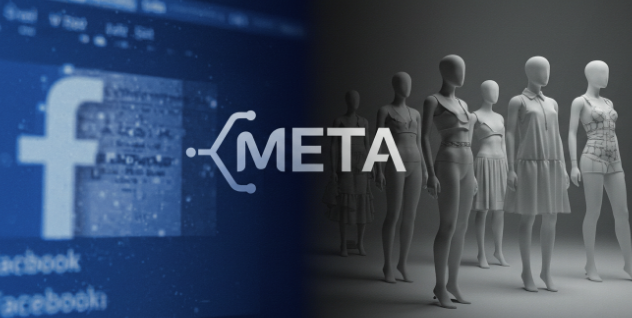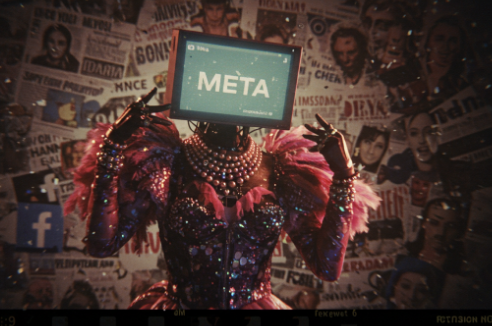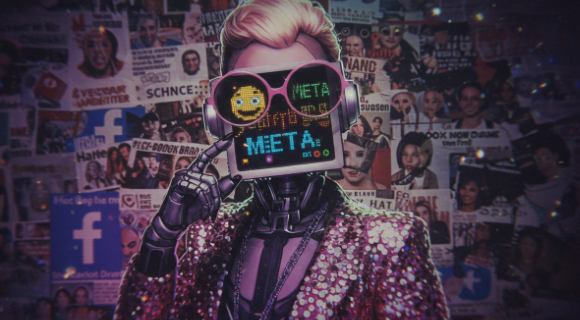Stock Symbol: META | Current Price: ~$575 (September 2025) | Target Price: $700+ | Timeframe: 12-18 months
Remember when Meta was just Facebook and everyone’s biggest concern was their aunt’s political posts? Those simpler times are long gone. Meta has transformed from social media drama central into an AI powerhouse that somehow convinced people to wear computers on their faces and call it fashion. With Q2 2025 revenue hitting $47.5 billion (up 22% year-over-year) and Mark Zuckerberg promising to build “personal superintelligence for everyone,” Meta is proving that pivot stories don’t always end in disaster. Sure, Reality Labs is still burning $4.5 billion per quarter like a very expensive campfire, but those Ray-Ban smart glasses are actually selling, and the AI revolution is finally making the metaverse bet look less like science fiction and more like inevitable reality.
The AI Makeover: When Zuckerberg Got Smart

Meta’s AI transformation feels like watching your awkward high school classmate show up to the reunion as a successful entrepreneur. The company’s Llama 3.2 models have become the open-source darlings of the AI world, proving that sometimes giving away your best technology for free is actually brilliant strategy. It’s like the ultimate loss leader, except instead of selling milk cheap to get people into the grocery store, Meta is giving away AI models to get developers addicted to their ecosystem.
The Ray-Ban Meta smart glasses represent perhaps the most successful consumer AI product nobody saw coming. Meta’s popular Ray-Ban Smart Glasses are getting new AI abilities that let it handle live translation, remind you where you parked, and more, turning everyday eyewear into your personal AI assistant. It’s like having Siri, but stylish enough that people won’t judge you for talking to yourself in public.
Multimodal AI models capable of processing multiple different types of inputs like speech, text, and images have been transforming user experiences in the wearables space, and Meta has figured out how to cram this technology into glasses that don’t make you look like a cyborg. This is no small feat, considering Google Glass made everyone look like they were auditioning for a dystopian sci-fi movie.
The Money Machine: AI-Powered Advertising Gold Rush

Meta’s core business remains beautifully simple: show people content, collect their attention, sell that attention to advertisers. But now they’re doing it with AI superpowers. Second quarter 2025 revenue reached $47,516 million, up 22% from $39,071 million in the prior year, proving that the AI integration isn’t just fancy tech demo stuff – it’s actually making money.
Meta Platforms’ AI-driven engagement boost, new features, and safety tools fuel ad revenue growth, which is corporate speak for “the robots figured out how to keep people scrolling longer and advertisers are paying premium prices for the privilege.” The company’s operating margin improved to 43%, because apparently when AI does the heavy lifting, profit margins get very happy.
The advertising business is benefiting from AI in ways that would make Don Draper weep with joy. Better targeting, improved ad performance, and engagement metrics that suggest people are actually enjoying their social media experience again. It’s like Meta found the secret sauce for making advertising less annoying while making it more effective – a combination that has advertisers throwing money at them faster than they can count it.
Reality Labs: The $4.5 Billion Science Experiment

Let’s address the elephant in the room: Meta’s Reality Labs posts $4.53 billion loss in second quarter, continuing its impressive streak of burning money like it’s going out of style. But here’s the thing about expensive science experiments – sometimes they work out.
The Ray-Ban collaboration has proven that people will wear smart glasses if they look normal and do useful things. Ray Ban Meta glasses will be able to record and send voice messages on WhatsApp and Messenger, get video help and suggest items and places when you’re out, turning everyday activities into seamlessly connected experiences. It’s like having a really helpful friend who never gets tired of answering your questions and never judges you for asking where you parked your car for the third time this week.
The metaverse vision is slowly becoming less “Second Life with better graphics” and more “the next computing platform that happens to be spatial.” With AI making virtual interactions more natural and AR making digital overlays actually useful, Meta’s expensive bet is starting to look less like digital real estate speculation and more like infrastructure investment for the future of computing.
The Llama Strategy: Give Away Ice Cream, Sell Freezers

Meta’s decision to open-source their Llama models initially seemed like corporate charity or competitive desperation, but it’s actually brilliant strategy disguised as generosity. Llama 3 models will soon be available on AWS, Databricks, Google Cloud, Hugging Face, Kaggle, IBM WatsonX, Microsoft Azure, NVIDIA NIM, and Snowflake, creating an ecosystem where Meta’s AI becomes the foundation everyone else builds on.
It’s the classic platform play: give away the foundation, profit from everything built on top. Developers using Llama models become invested in Meta’s AI ecosystem, enterprises get comfortable with Meta’s technology, and suddenly Meta isn’t just the social media company anymore – they’re essential AI infrastructure. It’s like becoming the roads that everyone else’s businesses depend on.
The open-source approach also creates a massive competitive moat disguised as open collaboration. When thousands of developers are improving your models for free, and millions of applications depend on your platform, switching costs become astronomical even when the technology is theoretically “free.”
Investment Outlook: The Transformation Payoff
Meta’s stock represents one of the cleaner plays on the AI transformation of consumer technology. Unlike pure-play AI companies with uncertain business models, Meta has figured out how to monetize AI through their existing advertising machine while building new revenue streams through hardware and platform services.
The company’s massive user base provides the data advantage necessary for AI development, their advertising business provides the cash flow to fund expensive R&D, and their platform reach ensures that successful AI products get distribution at unprecedented scale. It’s like having a money printing machine that funds a research laboratory that builds products for the world’s largest distribution network.
Key risks include regulatory scrutiny (because apparently having billions of users makes governments nervous), competitive pressure from other AI platforms, and the ongoing Reality Labs money bonfire. But the combination of core business strength and emerging technology leadership creates multiple pathways to continued growth.
Price Target: The Math on AI Fashion
Based on Meta’s AI transformation success, advertising business strength, and emerging hardware opportunities, the company presents a compelling investment opportunity with a 12-18 month price target of $700+ per share. This reflects both multiple expansion as investors recognize the successful pivot and fundamental growth from AI monetization.
Key catalysts include continued advertising revenue growth driven by AI improvements, Ray-Ban smart glasses sales acceleration, Reality Labs losses stabilization (or ideally reduction), and successful expansion of the Llama ecosystem. The convergence of these factors creates a pathway to significant value creation as Meta completes its transformation from social media company to comprehensive AI platform.
Meta has successfully evolved from “move fast and break things” to “move fast and fix everything with AI,” and the financial results suggest investors are finally believing the transformation story. For investors seeking exposure to consumer AI adoption through a company with proven monetization capabilities and massive distribution advantages, Meta represents an attractive opportunity to benefit from the AI revolution with a side of fashionable smart glasses.
Disclaimer: This analysis contains jokes about corporate pivots and should not be considered personalized investment advice. Past performance does not guarantee future results, though Meta’s track record suggests they’re remarkably good at making money from people’s attention spans. Consult with a qualified financial advisor who hopefully understands both AI and fashion trends.
Last Updated: September 2025
Next Review: December 2025








